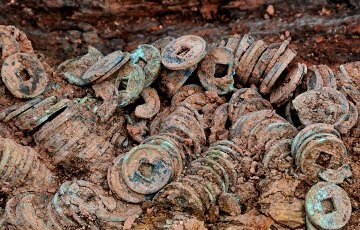Chinese archaeologists have unearthed more than 10 tons of ancient coins dating back to the West Han Dynasty (206 B.C. - A.D. 25) at royal tombs in East China’s Jiangxi Province, The Mirror reported on Thursday, Nov. 5.
According to the report, the 2 million copper wuzhu coins were excavated from the imperial tomb for the Marquis of Haihun State, near present-day Nanchang. The dig is estimated to be equivalent to 10 million yuan ($1,575,000) in the currency of the time.
When found, the copper coins are grouped in strings of 1,000, a monetary unit used at the time, Xu Changqing, head of the Jiangxi Provincial Institute of Cultural Relics and Archaeology, explained.
The institute said that more than 10,000 objects have been uncovered at the site over the past five years, which have helped paint a picture of the life of aristocrats during the West Han Dynasty.
The report said that tombs were considered by archaeologists as the most well-preserved example of West Han Dynasty royalty ever discovered.
In 2011, archaeologists also discovered the terracotta and painted pottery culture that flourished around 4,000 B.C., during excavations of the Laohudun Site in Gaohu, Jing'an, in Jiangxi Province.
Some stoneware, including hatchets, adze, stone ploughs and stone walls, as well as some pottery ware, were also found in areas around the site. The items were estimated to be 6,000 years old.
Among other things, archaeologists also excavated a giant sacrificial table aged between 4,000 and 5,000 years, 114 sacrificial tombs and an architectural ruin made from red scorched earth.
The 2011 site is located in the middle of a rice paddy field in Gaohu County, Jing'an, which has been identified as an area of ancient mound cultural relics.



























